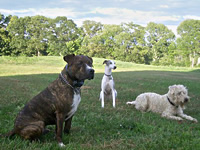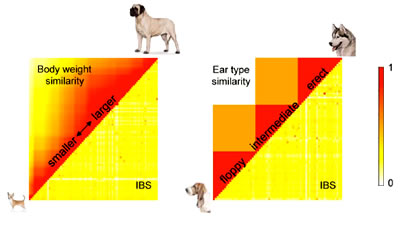Last updated: November 15, 2012
Diversity of Canine Traits Attributed to Simple Genetic Architecture
Diversity of Canine Traits Attributed to Simple Genetic Architecture
 |
The domestic dog (Canis familiaris) diverged from the gray wolf on the canine family tree more than 15,000 years ago. Today, due to selective breeding by humans throughout history, dogs exhibit an extremely wide range of body types and canine behaviors. Moreover, because selective reproduction resulted in great variation in shape and size among all dogs, but strong similarity within breeds, researchers now study dogs to understand heredity, evolutionary principles and health conditions in these animals and, by comparison, in humans.
The research has produced some surprises. A national team that includes researchers from the National Human Genome Research Institute's Cancer Genetics Branch has found that a surprisingly simple genetic architecture underlies the great variation in domestic dogs. They have plotted this architecture in a high-density map of canine genetic variation. The study appears in the August 10, 2010 issue of PLoS Biology.
"We undertook a study of the largest number of domestic dogs studied at such a high level of genetic detail," said senior author and NHGRI Cancer Genetics Branch Chief Elaine A. Ostrander, Ph.D. "This data and the analysis we have applied underscores the power of the dog as a model for discovery of genes that control the body plan in mammals."
The researchers developed a map of canine genetic variation by genotyping 915 dogs from 80 domestic breeds, as well as 83 wild dogs and 10 African shelter dogs. Their analysis spanned almost 70,000 points along the genome of these dogs. They also obtained physical measurements that are characteristic of particular breeds. Their map of phenotypes comprises 57 traits, including body size and dimensions, cranial and dental shape, and long bone shape.
"Our breed-mapping approach allowed us to look for correlations between gene markers and traits in the breeds," Ostrander said. The study took a close look at the markers that corresponded with body size variation and ear carriage, whether floppy or erect. The researchers confirmed gene regions, or locations of particular genes, where associations with body size in dogs were previously identified and added two additional important gene regions to this trait. Wild dogs typically have erect ears, but many dog breeds have floppy ears. The researchers found a single gene region likely responsible for this trait. For the majority of additional traits measured, most of the variance across breeds could be accounted for with a small number of gene regions.
 |
The findings result from a collaboration called the CanMap project, which uses the dog as a model system to identify genomic regions responsible for many key physical characteristics. In addition to NHGRI researchers, the study co-authors are from Stanford University School of Medicine; Cornell University in Ithaca, N.Y.; the University of California, Los Angeles; Affymetrix Corporation, Santa Clara, Calif.; and the University of Missouri, Columbia.
Over the past three years, researchers have identified dozens of genetic variants that influence breed-defining traits, including those for skeletal size, coat color, leg length, hairlessness, wrinkled skin, hair length, curl and texture, and the presence of a dorsal fur ridge. By mapping the common genetic variation in the domestic dog, the researchers in the present study expanded the list and made some general observations about the genomic patterns that influence many of these physical traits in dogs.
The study showed that observable traits in domestic dogs are defined by a small number of genetic variants. By contrast, studies of humans and other species, including laboratory animals and domestic plants, have found that common traits, such as body size and lipid levels, are the result of many genetic variants working together.
How do the researchers explain the pattern in dogs of a small number of gene variations having such large effect? One reason is that many modern breeds were created during the Victorian Era when breeders selected particular novelty traits. The researchers describe some events in the breeding of dogs as bottlenecks, where a breed is derived from a small number of founders. This simpler genetic architecture provides unique insights into the potential of evolutionary change under domestication.
This latest work utilized and built upon data generated by the NHGRI-supported sequencing and analysis of the dog genome. Researchers can access the dog sequence data through the following public databases: Dog Genome Resources (www.ncbi.nlm.nih.gov/genome/guide/dog) at NIH's National Center for Biotechnology Information (NCBI); EMBL Bank (www.ebi.ac.uk/index.html) at the European Molecular Biology Laboratory's Nucleotide Sequence Database; UCSC Genome Browser (www.genome.ucsc.edu) at the University of California at Santa Cruz; and at the Broad Institute Dog Genome Sequencing Project Web site (www.broadinstitute.org/mammals/dog). The genotyping data from the current study is available by sending a request to dog_genome@mail.nih.gov.
The article is available online in PLoS Biology and may be accessed at A Simple Genetic Architecture Underlies Morphological Variation in Dogs [genetics.plosjournals.org].
